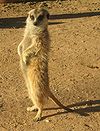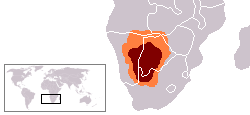Kalahari Desert
The Kalahari Desert is a large arid to semi-arid sandy area in southern Africa extending 900,000 km², covering much of Botswana and parts of Namibia and South Africa, as semi-desert, with huge tracts of excellent grazing after good rains.[1] The surrounding Kalahari Basin covers over 2.5 million km² extending farther into Botswana, Namibia, and South Africa, and encroaching into parts of Angola, Zambia, and Zimbabwe. The only permanent river, the Okavango, flows into a delta in the northwest, forming marshes that are rich in wildlife. Ancient dry riverbeds—called omuramba—traverse the central northern reaches of the Kalahari and provide standing pools of water during the rainy season. Previously havens for wild animals from elephant to giraffe, and for predators such as lion and cheetah, the riverbeds are now mostly grazing spots, though leopard or cheetah can still be found.
Climate
Derived from the Tswana word Keir, meaning the great thirst, or the tribal word Khalagari or Kalagare (meaning "a waterless place"[1]), the Kalahari has vast areas covered by red-brown sands without any permanent surface water. Drainage is by dry valleys, seasonally inundated pans, and the large salt pans of the Makgadikgadi Pan in Botswana and Etosha Pan in Namibia. However, the Kalahari is not a true desert. Parts of the Kalahari receive over 250 mm of erratic rainfall annually and are quite well vegetated; it is only truly arid in the south-west (under 175 mm of rain annually) making the Kalahari a fossil desert. Summer temperatures in the Kalahari range from 20 to 40 °C. In winter, the Kalahari has a dry, cold climate with frosts at night. The low winter temperature can average below 0 °C. In addition, this desert was the setting for the movie "The Gods Must Be Crazy."
Game reserves

The Kalahari has a number of game reserves - the Central Kalahari Game Reserve (CKGR), the world's second largest protected area); Khutse Game Reserve; and the Kgalagadi Transfrontier Park. The area's remoteness, unforgiving climate, and harsh terrain have kept it pristine. Animals that live in the region include brown hyenas, lions, meerkats, several species of antelope (including the oryx or gemsbok), warthogs, cheetahs, wild dogs, leopards, and many species of birds and reptiles. Vegetation in the Kalahari consists mainly of grasses and acacias but there are over four hunded identified plant species present (including the wild watermelon or tsamma melon).
For seven years, Mark and Delia Owens lived in tents, and studied a pristine wilderness and its inhabitants. They did landmark research on black-maned Kalahari lions and the elusive brown hyena. After surviving violent storms, wildfires, and 120-degree heat during their research, they chronicled their findings in their book Cry of the Kalahari.
Ancestral land
The area is the ancestral land of the Bushmen (San) peoples. There are many distinct tribes, and they have no collective name for themselves. The names San and Basarwa are sometimes used, but the people themselves dislike these names (San is a Khoikhoi word meaning outsider, and Basarwa a Herero word meaning person who has nothing) and prefer the name "Bushman". Their language, Khoisan, is a language of clicks. The name bushmen was given to them by early settlers who may have named them for the fact they live in the bush or it might have been given because of their use of aromatic spices collected from various bushes. They are thought to have been the first human inhabitants of Southern Africa; there is evidence that they have been living there continuously as nomadic hunter-gatherers for over twenty thousand years.
The Bushmen were first brought to the Western world's attention in the 1950s when South African author Laurens van der Post published his famous book The Lost World of the Kalahari, which was also turned into a BBC TV series. This and other later works about the Kalahari prompted the British colonial authorities to create the Central Kalahari Game Reserve in 1961 to preserve the Bushmen and the wildlife. After independence, Botswana provided food, water, and medical care to them, but eventually they began raising goats and planting crops. Wildlife officials were concerned about the impact on the environment and thegovernment balked at providing services to remote villages. About three thousand of the estimated hundred thousand remaining Bushmen moved into settlements.
Some two hundred, however, sued the government of Botswana for the right to return to their homeland, and the High Court ruled in December 2006 that the Bushmen are entitled to live and hunt on their ancestral lands. However, it placed limits on what they could take with them. They cannot bring domesticated animals with them or build permanent structures. Hunters will have to apply for permits. And only those named in the original lawsuit may return.
Today the Bushmen are offering a taste of their life to tourists to bring in money. Bushman activities that can be experienced by visitors include identifying natural salt/mineral licks and caves; trees, bushes, spoor, birds, and other animals; and gathering and preparing foods. Tourists can learn to do dances and play the foot bow, as well as identify medicinal plants and their uses or go on a a guided simulation hunt. They can see traditional skills demonstrated, such as making traditional "jewelry" from ostrich eggshells, glass beads and seeds; tanning skins and curing hides; and making rope and glue.
Natural resources
Minerals
There are large coal, copper, nickel, and uranium deposits in the region. One of the largest diamond mines in the world is located at Orapa in the Makgadikgadi, North-Eastern Kalahari. Pomfret, on the edge of the desert, has asbestos in the subsoil and a shuttered asbestos mine.[2]
Diamond mining
WThe overseas campaign group Survival International say the real reason for the re-settlement of Bushmen by the Botswana government is to free up the land for diamond mining, especially in the area of Orapa, the diamond capital of the country. But the Botswana Centre for Human Rights, Ditshwanelo, disputes this, claiming that the government is being altruistic but misguided.
Plants
As one might expect from a unique landscape such as the Kalahari desert, it contains many unique plants. Add to this the aeons old experience and knowledge of the San or Bushman and you have a wealth of botanical medicines that can and have been exploited, both historically and at present.
The great value of Devil’s claw or Harpagophytum, as a natural medicine was learned by the Germans (from the Bushmen) during the last century. This has resulted in a multi-million dollar international industry, which has incidentally led to the local extinction of the plant in many areas. Sad to say, the San or Bushman did not see a dime of all this money. The latest wonder medicine to come from the Kalhari, is “Hoodia”, the miracle “Bushman solution to appetite control”. The South African Council for Scientific and Industrial Research (CSIR) discovered the valuable properties of this plant in the 1970’s and extracted and tested a miracle ingredient which was later dubbed “P75”. Besides being an almost ideal appetite supressor, P75 had several other valuable medical properties.
The Kalahari was first crossed to Lake Ngami by David Livingstone, accompanied by William C. Oswell, in 1849. In 1878-1879 a party of Boers, with about three hundred wagons, trekked from the Transvaal across the Kalahari to Ngami and thence to the hinterland of Angola. Many of the party, men, women and children, perished of thirst during the journey. Survivors stated that in all some 250 people and 9000 cattle died.
ReferencesISBN links support NWE through referral fees
- "Court victory proves hollow for Bushmen," Washington Times, January 18, 2007.
- Marq de Villiers and Sheila Hirtle, Into Africa: A Journey through the Ancient Empires, 1997. Key Porter Books, Toronto, Canada. ISBN 1550138847
External links
- Flying to the Kalahari
- "Cry of the Kalahari"
- Central Kalahari Game Reserve Pictures, Botswana
- Dream an electronic dream of the Kalahari
- Tourism and Produce of the Kalahari Region
- Destination information about the Kalahari Desert.
Credits
New World Encyclopedia writers and editors rewrote and completed the Wikipedia article in accordance with New World Encyclopedia standards. This article abides by terms of the Creative Commons CC-by-sa 3.0 License (CC-by-sa), which may be used and disseminated with proper attribution. Credit is due under the terms of this license that can reference both the New World Encyclopedia contributors and the selfless volunteer contributors of the Wikimedia Foundation. To cite this article click here for a list of acceptable citing formats.The history of earlier contributions by wikipedians is accessible to researchers here:
The history of this article since it was imported to New World Encyclopedia:
Note: Some restrictions may apply to use of individual images which are separately licensed.
- ↑ 1.0 1.1 Mary Sadler-Altena, "Kalahari: Introduction" webpage: Template:Dlw: Kalahari name/climate/reserves and history.
- ↑ South Africa - Pomfret. abc.net. Retrieved 2007-01-03.

